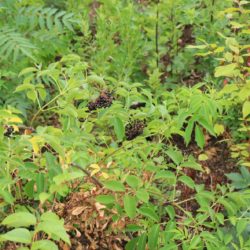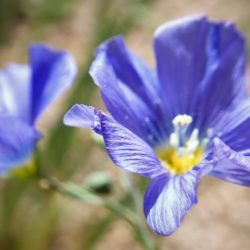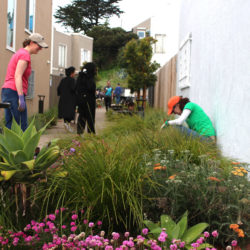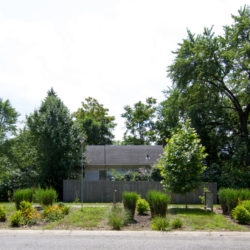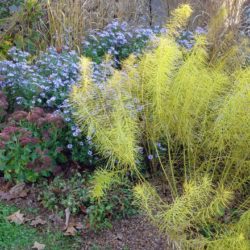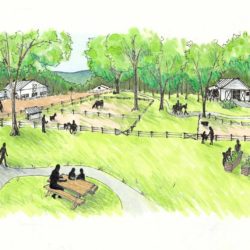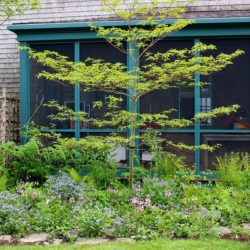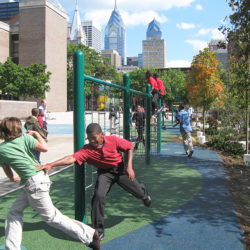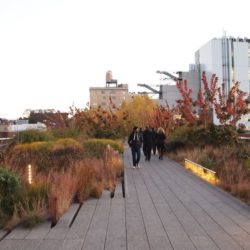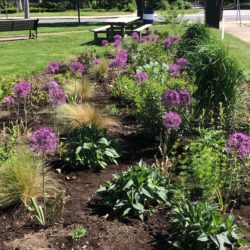There is no excerpt because this is a protected post.
Urban Landscaping
Myawaki Forest in Cambridge, Mas
MYAWAKI FOREST IN CAMBRIDGE, MASS. Written by: Leslie Duthie It is a beautiful 50′ circle of green in the dry park. Despite the severe drought, the trees look good and…
Demonstration Garden Beautifies Area Teaches Others About Native Plants
By Lisa Olsen
In an active Denver neighborhood, volunteers proposed the Greenverien Garden to improve the neighborhood’s livability. They saw an opportunity to beautify the area by transforming the asphalt-covered strip on a busy street corner into a low-maintenance landscape to be enjoyed by residents, pollinators and visitors alike.
Ridge Lane: The Butterfly Effect of an Urban Vacant Lot
By Nahal Sohbati
Located in the Ingleside neighborhood of San Francisco, Ridge Lane is a vacant public right of way owned by the city. Vacant lands can serve as a public space and can significantly contribute to social engagement. Community members often take charge of these vacant lots and activate them through community gardening, guerrilla gardening, and other artful representations.
Winning Community Support for Green Infrastructure
by Sandra Albro
In this adapted excerpt from Vacant to Vibrant: Creating Successful Green Infrastructure Networks (Island Press, 2019), author Sandra Albro shares lessons from a multidisciplinary project team that built nine green stormwater parks on small vacant lots in three post-industrial cities—Gary, Indiana; Cleveland, Ohio; and Buffalo, New York. The project, “Vacant to Vibrant,” replicated similar processes across three Great Lakes states with the goal of discerning site-specific considerations from more generalizable lessons.
Planting Landscape Niches
By Susan Barton
In today’s rapidly urbanizing environment, we have a unique opportunity, if not a duty, to create livable landscapes that are attractive, easily managed, and provide a rich complement of plants to support diverse ecosystems. Let’s adapt a naturalistic design aesthetic that allows us to use native plants in home gardens, reflecting our regional spirit of place.
Huertos Accessibles Para Todos
By Rachel Lindsay
Un paisaje accesible debe ser fácil de acceder físicamente y también ofrecer experiencias variadas a todos los visitantes. Los diseñadores ecológicos llevan el concepto de diseño universal aún más lejos y consideran cómo el paisaje, especialmente los jardines públicos y participativos, pueden beneficiar no solo a personas de todas las capacidades, sino también a la vida silvestre, los polinizadores, los microorganismos del suelo y las cuencas hidrográficas.
What Is Rewilding?
by Heather McCargo and Anna Fialkoff
The term rewilding first appeared in the conservation world in the 1980s with a continental-scale vision to protect large tracts of wilderness and connect these areas with migration corridors. Maine’s Wild Seed Project considers rewilding to be not just for the large wilderness areas or charismatic megafauna like wolves. Instead, they focus on actions that people can take right outside their doors.
Green Stormwater Infrastructure
By Anna Shipp
Our current economic downturn caused by COVID-19 and ongoing social and climate crisis demands a transformational change in everything from business practices to public policy, including how we approach stormwater management. In rebuilding our economy, the government must prioritize green stormwater infrastructure because it’s a tool that fosters job growth, public health, community well-being, and resiliency.
Urban Wilderness and the “High Line Problem”
By Emma Marris
In October of 2013, I toured three miles of disused railroad line in Philadelphia. The entire line was covered with spontaneous vegetation alive with butterflies and ladybugs. Here nature was showing us her resilience and her wild beauty and offering to meet us where most of us live now, in the city. What is tricky about urban wildness is what I call the High Line Problem.
Celebrating Natives Garden Tour – Needham, MA
Hosted by Marie Chieppo
Avery Park, a busy commuter rail station park becomes a native plant oasis for people and pollinators alike. Follow Needham based landscape designer Marie Chieppo’s journey through a barren weed-infested plot to a popular garden gathering spot that is doing double duty during the COVID pandemic as a great place to socialize while staying six feet apart.
“Every parcel has promise”- Restoration in the Urban Habitat
by Miho Connolly
The Challenges of Restoring Urban Native Habitat, presented by Dr. Steven Handel at the 25th Annual ELA Conference, centered around a modern reality: with population growth and the spread of urban areas, cities have become a new and important habitat type. While many might consider cities to be ecologically sterile sources of environmental problems, Handel sees environmental opportunity.

